Integrated nutrient management in summer cowpea (Vigna unguiculata L.) under south gujarat condition
Bạn đang xem bản rút gọn của tài liệu. Xem và tải ngay bản đầy đủ của tài liệu tại đây (288.85 KB, 10 trang )
Int.J.Curr.Microbiol.App.Sci (2018) 7(9): 1513-1522
International Journal of Current Microbiology and Applied Sciences
ISSN: 2319-7706 Volume 7 Number 09 (2018)
Journal homepage:
Original Research Article
/>
Integrated Nutrient Management in Summer Cowpea
(Vigna unguiculata L.) Under South Gujarat Condition
K.L. Pargi1, R.L. Leva2, H.Y. Vaghasiya3* and H.A. Patel1
1
Department of Agronomy, N. M. College of Agriculture, Navsari Agricultural University
(NAU), Navsari, Gujarat, India
2
Division of Plant Biotechnology, 3Division of Microbial and Environmental Biotechnology,
Aspee Shakilam Biotechnology Institute, NAU, Surat, Gujarat, India
*Corresponding author
ABSTRACT
Keywords
Cowpea, RDF,
Rhizobium, Phosphate
solubilizing bacteria,
FYM
Article Info
Accepted:
10 August 2018
Available Online:
10 September 2018
A field experiment entitled “Integrated nutrient management in summer cowpea (Vigna
unguiculata L.) under South Gujarat condition” conducted at Navsari with eight treatment
combinations replicated thrice in factorial randomized block design during the summer
season of 2016. The treatment consisted combinations of two levels of inorganic fertilizers
(F1:50 % RDF, F2:100 % RDF); two levels organic manures (O1: FYM @ 0 t ha-1, O2:
FYM @ 2.5 t ha-1) and two levels bio-fertilizers (B1: No inoculation, B2: seed inoculation
with Rhizobium and phosphate solubilizing bacteria). As regards the growth parameters
the higher plant height (cm), number of branches per plant, days to 50 % flowering,
number of nodules per plant, dry matter per plant (g), number of pod per plant, number of
seed per pod, 100 seed weight (g), higher grain (kg ha-1), haulm yield (kg ha-1), harvest
index (%) were significantly increased to a greater extent by the treatment 100 % RDF
(F2), FYM @ 2.5 t ha-1 (O2) and seed inoculation with Rhizobium and phosphate
solubilizing bacteria (B2) which was found significantly differ from the 50 % RDF (F 1),
FYM @ 0 t ha-1 (O1) and No inoculation (B1) treatments.
Introduction
Cowpea (Vigna unguiculata L.) is a
multipurpose kharif and warm season pulses
crop, commonly cultivated all over India. It is
also called as black eye pea, black eye bean,
southern pea, china pea, marble pea, chowli
and lobiya. West Africa and India are the
centers of diversified for cowpeas. Cowpea is
cultivated as seed, green vegetable and fodder
in many diverse agriculture systems in many
countries of Africa, Latin America, and south
East Asia and in the southern United States
(Singh et al., 2012). The largest cowpea seed
producing nation are Africa, Nigeria, India,
Brazil, Haiti, Myanmar, Sri Lanka, Bosnia,
Australia and other West African countries.
Cowpea is also called vegetable meat due to
high amount of protein having better
biological value. The mature cowpea seed
1513
Int.J.Curr.Microbiol.App.Sci (2018) 7(9): 1513-1522
contains 24.8 per cent protein, 63.6 per cent
carbohydrate, 1.9 per cent fat, 6.3 per cent
fiber, 0.00074 per cent thiamine, 0.00042 per
cent riboflavin and 0.00281 per cent niacin as
well as rich source of calcium and iron (Shaw
M, 2007). Besides human consumption,
cowpea may be suitably grown as forage,
green manuring, cover crop and catch crop. It
is also one of the alternatives in dry land
farming systems as a mixed intercrop due to
its fast growing habit and being legume. In
India, cowpea is cultivated mainly in
Rajasthan, Maharashtra, Karnataka, Gujarat,
Tamil Nadu, Andhra Pradesh and Madhya
Pradesh. In India, area under cowpea is 654
lakh hectares with a production of 599 lakh
tonnes with productivity of 916 kg ha-1 (Josji
et al., 2018).
Cultivation of cowpea in summer season is
increasing in Gujarat, especially in south
Gujarat where perennial water supply from
Ukai- Kakrapara project is available to meet
the demand of irrigation. There is uncontrolled
and discriminate use of chemical fertilizer has
deteriorated the soil health, leading to drastic
decline in crop productivity. Therefore, there
is a need to use organic fertilizer like FYM
and bio-fertilizers. Integrated or balance use of
chemical and organic fertilizer not only
increase the crop yield, but also improves the
soil health. Role of these manures are
undisputed but their unavailability and bulky
nature limit their use. Gaur et al., (1990)
reported that organic N is slowly mineralized
and about 30 % N, 70 % P2O5 75 % K2O is
likely become available to the first crop and
the rest of the nutrients to succeeding crops.
Judicious use of chemical fertilizer: organic
manures in 1:1 or 7:3 ratios maintain
sustainable soil quality (Shankaram A, 1996).
The efficient application of chemical
fertilizers have played very significant role in
providing nutrients
for growth and
development of plants. Among different
nutrients, nitrogen is one of the most
expensive and important nutrient. Cowpea
utilizes
atmospheric
nitrogen
through
symbiotic fixation to meet a major part of
nitrogen requirement of crops. However, it
requires a starter dose of nitrogen to boost up
early growth and establishment. A sizeable
amount of applied nitrogen could be lost as
ammonia by volatilization from soil surface;
nitrous oxide or elemental nitrogen by
denitrification and nitrates by leaching in
ground water. Indian soils are rich in
phosphorus but more than two-thirds of the
native phosphates are unavailable and applied
phosphatic fertilizers rendered unavailable
within a short period due to its chemical
fixation in the soil as it is immobile in the soil.
Bio-fertilizers are formulations of beneficial
microorganisms, which upon application can
increase the availability of nutrients by their
biological activity and help to improve the soil
health for increasing soil fertility. Among
different bio-fertilizers Rhizobium inoculation
can increase the grain yield of pulse crops to
the tune of 10 to 15 per cent.
Phosphate solubilizing bacteria (PSB) have
the consistent capacity to increase the
availability of phosphates to plants by
mineralizing phosphorus compounds. Both the
demand for larger amount of fertilizers and
associated drain on foreign exchange and the
associated environmental problems have
forced us to think of alternate sources of plant
nutrients. These needs have led to the
development of the concept of INM. The
concept of INM is the rationalization of plant
nutrient management in order to upgrade the
efficiency of plant nutrient supply to the crops
resulting ultimately in higher productivity and
income to the farmers including better impact
on environment. It would be very necessary
for a crop like cowpea to study various
techniques in detail in order to improve its
productivity and quality.
1514
Int.J.Curr.Microbiol.App.Sci (2018) 7(9): 1513-1522
Materials and Methods
Results and Discussion
The experiment was taken up on plot E - 23 of
the College Farm, N. M. College of
Agriculture, Navsari Agricultural University,
Navsari during summer season of 2016. The
experimental field was fairly leveled and
uniform in fertility. The soil popularly known
as “Deep Black” soils was an old alluvium of
basaltic material by its origin. According to
the seventh approximation, the soil of the
experimental field is classified under the
group Ustochrepts, sub group of Vertic
ustochrepts, sub order orchrepts and order
inceptisols with Jalalpur series. Soils are deep,
moderately drained having good water holding
capacity.
Growth and yield parameters
The soil crack heavily on drying and expands
on wetting. The predominant clay mineral is
montmorillonite. The soils having a 7.8 pH,
low in organic carbon content (0.53%),
medium in available N (197.26 kg ha-1), P
(30.93 kg ha-1) and higher in available K
(369.80 kg ha-1). The experiment comprising
eight treatment combinations were laid out in
factorial randomized block design with tree
replication.
The
treatment
consisted
combinations of two levels of inorganic
fertilizers (F1: 50 % RDF, F2: 100 % RDF);
two levels organic manures (O1: FYM @ 0 t
ha-1, O2: FYM @ 2.5 t ha-1) and two levels
bio-fertilizers (B1: No inoculation, B2: seed
inoculation with Rhizobium and phosphate
solubilizing bacteria). In each plot five plants
were selected at random and tagged for
observations.
Observations on yield and its attributing
characters viz., plant height (cm), number of
branches per plant, days to 50 % flowering,
number of nodules per plant, dry matter per
plant (g), number of pod per plant, number of
seed per pod, 100 seed weight (g), grain yield
(kg ha-1), haulm yield (kg ha-1), harvest index
(%) were recorded.
Effect of inorganic fertilizer
Data presented in Table 1 revealed that
difference in plant height at 20 DAS, at 40
DAS, at 60 DAS and at harvest were
influenced significantly by the effect of
inorganic fertilizers. Plant height at initial
stage of crop growth i.e. at 20 day after
sowing (DAS) was found non-significant.
Significantly the highest plant height at 40
DAS i.e. 31.77 cm, at 60 DAS i.e. 42.73 cm
and at harvest i.e. 45.39 cm was recorded with
100 % RDF (F2). Thus there is an increase in
plant height with application of 100 % RDF
throughout the crop growth span. The
probable reason might be positive effect of
nutrient on growth character due to augment
of cell division and cell expansion. The study
was in close conformity as observed by
Abayomi et al., (2008), Dekhane et al.,
(2011), Khandelwal et al., (2013), Khan et al.,
(2015) and Josji et al., (2018)
Number of branches per plant at harvest was
also increased with an increase in 100 % RDF
(F2) (Table 1) Nitrogen enhances the
development of strong cell walls and therefore
stiffer branches which might be resulted into
profuse branches of cowpea. These results are
already in agreement with those reported by
Abayomi et al., (2008), Dekhane et al.,
(2011), Khandelwal et al., (2013), and Khan et
al., (2015).
Most of the growth character and yield
attributes viz., days to 50% flowering, number
of nodules per plant, dry matter per plant,
number of pod per plant, number of seed per
pod and 100 seed weight were significantly
higher with treatment F2 (100 % RDF).
Adequate major nutrients might have helped
in harvesting of solar energy as reflected by
1515
Int.J.Curr.Microbiol.App.Sci (2018) 7(9): 1513-1522
increased dry matter accumulation. The
beneficial effect of inorganic fertilizer in
growth and yield attributes were also reported
by Qureshi et al., (2015), Sarawd et al.,
(2014), Satodiya et al., (2015), Sharma et al.,
(2015) and Josji et al., (2018).
Similarly, seed and haulm yields (Table 3) of
cowpea were also recorded significantly
higher with application of 100% RDF (F2)
than other treatment. Application of 100%
RDF gave significantly higher seed i.e. 917.58
kg ha-1 and haulm i.e. 2221.33 kg ha-1 yield.
The highest seed and haulm yield could be due
to the cumulative effect of improvement in
yield attributes viz., number of pod per plant,
number of seed per pod and 100 seed weight.
The improvement in seed yield, haulm yield
and harvest index were mainly on account of
increase in the growth parameters and yield
attributes of cowpea which resulted in higher
production of photosynthates were utilized by
the plant for development of sink under
adequate supply of nutrients due to increasing
in rate of inorganic fertilizer. These results are
also in agreement with findings of Khandelwal
et al., (2013), Sarawd et al., (2014), Khan et
al., (2015), Qureshi et al., (2015), Satodiya et
al., (2015), Sharma et al., (2015) and Joshi et
al., (2018)
Effect of organic manures
Data furnished in Table 1 indicated that
difference in plant height at 40 DAS, at 60
DAS and at harvest were influenced
significantly by the effect of organic manures.
Significantly the highest plant height at 40
DAS i.e. 31.87 cm, at 60 DAS i.e. 42.91 cm
and at harvest i.e. 45.46 cm was recorded with
FYM @ 2.5 t ha-1 (O2). Thus there is an
increase in plant height with application of
FYM @ 2.5 t ha-1 throughout the crop growth
span. The probable reason might be positive
effect of nutrient on growth character due to
augment of cell division and cell expansion.
The study was in close conformity as observed
by Sankar et al., (1999), and Qureshi et al.,
(2015).
Number of branches per plant at harvest was
also increased with an increase in FYM @ 2.5
t ha-1 (O2) (Table 1). Nitrogen enhances the
development of strong cell walls and therefore
stiffer branches which might be resulted into
profuse branches of cowpea. These results are
already in agreement with those reported by
Sarkar et al., (1997), Sankar et al., (1999),
Subbarayappa et al., (2009), and Qureshi et
al., (2015).
Most of the growth character and yield
attributes viz., days to 50% flowering, number
of nodules per plant, dry matter per plant,
number of pod per plant, number of seed per
pod and 100 seed weight were significantly
higher with treatment O2 (FYM @ 2.5 t ha-1).
It might be attributed to better availability of
nutrients at critical growth stages which
facilitated improved crop growth, yield
attributes and further translocation of nutrients
which ultimately affect pod formation
associated with increased seed per pod and
test weight of seed. The beneficial effect of
inorganic fertilizer in growth and yield
attributes were also reported by Sarkar et al.,
(1997), Sankar et al., (1999), Subbarayappa et
al., (2009), and Qureshi et al., (2015).
The seed and haulm yields (Table 3) of
cowpea were also increased with increase in
organic manures application under FYM @
2.5 t ha-1 (O2) wherein significantly higher
seed i.e. 919.58 kg ha-1 and haulm yield i.e.
2247.67 kg ha-1. The highest seed and haulm
yield could be due to the cumulative effect of
improvement in yield attributes viz., number
of pod per plant, number of seed per pod and
100 seed weight, Harvest index (Table 3) was
affected significantly by FYM @ 2.5 t ha-1
(O2).
1516
Int.J.Curr.Microbiol.App.Sci (2018) 7(9): 1513-1522
Table.1 Plant height, number of branches per plant of cowpea as influenced by inorganic
fertilizers, organic manures and bio-fertilizer
Treatments
Plant height (cm)
At 20 At 40 At 60 At harvest
DAS DAS DAS
Number of branches per
plant
At 60 DAS At harvest
(A) Inorganic Fertilizer
F1 - 50 % RDF
12.01
29.91
39.90
42.10
3.51
3.91
F2 - 100 % RDF
12.45
31.77
42.73
45.39
3.92
4.32
S.Em.±
0.27
0.56
0.89
1.08
0.088
0.087
C.D. at 5%
NS
1.70
2.71
3.26
0.268
0.266
O1 - 0 t ha-1
11.90
29.81
39.73
42.04
3.58
3.98
O2 - 2.5 t ha-1
12.56
31.87
42.91
45.46
3.86
4.25
S.Em.±
0.27
0.56
0.89
1.08
0.088
0.087
C.D. at 5%
NS
1.70
2.71
3.26
0.268
0.266
11.98
30.00
39.89
42.09
3.56
3.96
B2 - Seed inoculation 12.49
with Rhizobium and
phosphate solubilizing
bacteria
0.27
S.Em.±
31.70
42.75
45.40
3.88
4.28
0.56
0.89
1.08
0.088
0.087
NS
1.70
2.71
3.26
0.268
0.266
FXO
NS
NS
NS
NS
NS
NS
FXB
NS
NS
NS
NS
NS
NS
OXB
NS
NS
NS
NS
NS
NS
FXOXB
NS
NS
NS
NS
NS
NS
C.V. %
7.71
6.28
7.50
8.52
8.23
7.38
(B) Organic manures
(C) Bio-fertilizers
B1 - No inoculation
C.D. at 5%
Interactions
1517
Int.J.Curr.Microbiol.App.Sci (2018) 7(9): 1513-1522
Table.2 Number of nodules per plant, days to 50% flowering and dry matter accumulation of
cowpea as influenced by inorganic fertilizers, organic manures and bio-fertilizer
Treatments
Number of nodules Days to 50 % Dry matter accumulation per
per plant
flowering
plant (g)
At 60 At harvest
At 60 DAS
At harvest
DAS
(A) Inorganic Fertilizer
F1 - 50 % RDF
46.00
42.52
42.00
22.91
32.80
F2 - 100 % RDF
49.28
45.78
45.28
24.65
35.30
S.Em.±
1.06
1.06
1.06
0.47
0.80
C.D. at 5%
3.22
3.22
3.22
1.45
2.44
O1 - 0 t ha-1
45.89
42.30
41.89
22.81
32.30
O2 - 2.5 t ha-1
49.39
46.01
45.39
24.75
35.81
S.Em.±
1.06
1.06
1.06
0.47
0.80
C.D. at 5%
3.22
3.22
3.22
1.45
2.44
45.94
42.38
41.94
22.95
33.15
B2
Seed 49.34
inoculation
with
Rhizobium
and
phosphate
solubilizing bacteria
1.06
S.Em.±
45.93
45.34
24.61
34.96
1.06
1.06
0.47
0.80
3.22
3.22
3.22
1.45
2.44
FXO
NS
NS
NS
NS
NS
FXB
NS
NS
NS
NS
NS
OXB
NS
NS
NS
NS
NS
FXOXB
NS
NS
NS
NS
NS
C.V. %
7.73
8.33
8.43
6.98
8.20
(B) Organic manures
(C) Bio-fertilizers
B1 - No inoculation
C.D. at 5%
Interactions
1518
Int.J.Curr.Microbiol.App.Sci (2018) 7(9): 1513-1522
Table.3 Yield parameters of cowpea as influenced by various treatments
Treatments
(A) Inorganic Fertilizer
F1 - 50% RDF
F2 - 100% RDF
S.Em.±
C.D. at 5%
(B) Organic manures
O1 – 0 t ha-1
O2 – 2.5 t ha-1
S.Em.±
C.D. at 5%
(C) Bio-fertilizers
B1 – No inoculation
B2 – Seed inoculation with
Rhizobium and phosphate
solubilizing bacteria
S.Em.±
C.D. at 5%
Interactions
FXO
FXB
OXB
FXOXB
C.V. %
Number Number 100 seed Seed
of
pod of seed weight
yield
per plant per pod
(kg/ha)
Haulm
yield
(kg/ha)
Harvest
index
(%)
10.01
10.95
0.27
0.82
10.45
11.48
0.19
0.58
10.62
11.45
0.25
0.77
819.75
917.58
29.30
88.88
1998.93
2221.33
72.08
218.67
29.09
29.22
0.13
NS
9.90
11.06
0.27
0.82
10.38
11.56
0.19
0.58
10.57
11.51
0.25
0.77
817.75
919.58
29.30
88.88
1972.60
2247.67
72.08
218.67
29.30
29.01
0.13
NS
9.98
10.99
10.51
11.44
10.61
11.48
821.75
915.58
2024.52
2195.75
28.88
29.43
0.27
0.82
0.19
0.58
0.25
0.77
29.30
88.88
72.08
218.67
0.13
0.41
NS
NS
NS
NS
9.00
NS
NS
NS
NS
6.09
NS
NS
NS
NS
7.99
NS
NS
NS
NS
11.68
NS
NS
NS
NS
11.83
NS
NS
NS
NS
1.61
The improvement seed yield, haulm yield and
harvest index were mainly on account of
increase in the growth parameters and yield
attributes of cowpea due to increasing in rate
of organic manures. These results are also in
agreement with findings of Sarkar et al.,
(1997), Sankar et al., (1999), Subbarayappa et
al., (2009), and Qureshi et al., (2015).
Effect of bio-fertilizers
Data presented in Table 1 revealed that
difference in plant height at 40 DAS, at 60
DAS and at harvest were influenced
significantly by the effect of bio-fertilizers.
Significantly the highest plant height at 40
DAS i.e. 31.70 cm, at 60 DAS i.e. 42.75 cm
and at harvest i.e. 45.40 cm was recorded with
seed inoculation with Rhizobium and
phosphate solubilizing bacteria (B2).
Thus there is an increase in plant height with
application of seed inoculation with
Rhizobium and Phosphate solubilizing
bacteria throughout the crop growth span. The
probable reason might be positive effect of
nutrient on growth character due to augment
of cell division and cell expansion. The study
was in close conformity as observed by
Meena et al., (2015).
1519
Int.J.Curr.Microbiol.App.Sci (2018) 7(9): 1513-1522
Significantly higher for number of branches
per plant, days to 50% flowering, number of
nodules per plant, dry matter per plant,
number of pod per plant, number of seed per
pod and 100 seed weight were recorded under
the treatment of seed inoculation with
Rhizobium and phosphate solubilizing
bacteria (B2). This might be due to dual
inoculation benefited the plants by providing
atmospheric N and rendering the insoluble
phosphorus into available form. The enhanced
availability of P favored N fixation and rate of
photosynthesis and consequently led to better
growth and yield attributes. The beneficial
effect of bio fertilizer in growth and yield
attributes were also reported by Beena et al.,
(1990), Patel et al., (2013), Das et al., (2014),
Khandelwal et al., (2015) and Meena et al.,
(2015).
The seed and haulm yields (Table 3) of
cowpea were also affected significantly under
seed inoculation with Rhizobium and
phosphate
solubilizing
bacteria
(B2).
Significantly the higher seed i.e. 915.58 kg
ha-1 and haulm yield i.e. 2195.75 kg ha-1 were
recorded with treatment B2. These might be
due to significant and progressive effect of
dual inoculation of Rhizobium and phosphate
solubilizing bacteria on yield attributes
resulted in hiher seed & haulm yield. These
results are also in agreement with findings of
Dekhane et al., (2011), Patel et al., (2013),
Khandelwal et al., (2015), Khan et al., (2015)
and Meena et al., (2015).
Interaction Effect
Interaction effect of inorganic fertilizer,
organic fertilizers and bio fertilizers was
found non-significant for all the parameters.
While numerically higher grain and straw
yield obtained with the application of 100 %
RDF + FYM @ 2.5 t ha-1 + Seed inoculation
with Rhizobium and phosphate solubilizing
bacteria. Almost similar findings were also
reported by Sammauria et al., (2009) and
Gorade et al., (2014).
Based on one year field experimentation,
significantly the highest seed and haulm
yields were recorded with application of 100
% RDF, FYM @ 2.5 t ha-1 and seed
inoculation with Rhizobium and Phosphate
solubilizing bacteria in south Gujarat heavy
rainfall Agro-ecological situation III (AESIII).
References
Abayomi, Y.A., Ajibade, T.V., Sammuel,
O.F. and Sa’adudeen, B.F. 2008.
Growth and yield response of cowpea
(Vigna
unguiculata
(L.)
walp)
genotypes to nitrogen fertilizer (NPK)
application in the Southeren Guinea
Savanna Zone of Nigeria. Asian Journal
Plant Science, 7(2): 170-176.
Beena, S., Nair, S.K. and Mathew, J. 1990.
Varietal response and host varietal
specificity for nodulation by rhizobium
in cowpea. Legume Research, 13(3):
136-138.
Das, B., Wagh, A.P., Dod, V.N., Nagre, P.K.
and Bawkar, S.O. 2011. Effect of
integrated nutrient management on
cowpea. Asian Journal Horticulture,
6(2): 402-405.
Dekhane, S.S., Khafi, H.R., Raj, A.D. and
Parmar, R.M. 2011. Effect of
biofertilizer and fertility levels on yield,
protein content and nutrient uptake of
cowpea [Vigna unguiculata (L.) Walp.].
Legume Research, 34(1): 51-54.
Gaur, C.A. 1990. Soil Chemical Analysis.
Prentice-Hall of India Pvt. Ltd., New
Delhi.
Gorade, V.N., Chavanl, S., Jagtap, D.N. and
Kolekar, A.B. 2014. Response of green
gram (Vigna radiata L.) varieties to
integrated nutrient management in
1520
Int.J.Curr.Microbiol.App.Sci (2018) 7(9): 1513-1522
summer season. Agriculture Science
Digest, 34(1): 36-40.
Joshi, J.R., Patel, V.M., Barad, H.L.,
Macwan, S.M. and Javid, E. 2018.
Effect of land configuration and
fertilizer management practices on
growth, yield and yield attributes and
economics of summer cowpea (Vigna
unguiculata L.) under south Gujarat
condition. International Journal of
current Microbiology and Applied
Sciences, 7(1): 1148-1155.
Khan, V.M., Manohar, R.S., Verma, H.P.
2015. Effect of vermicompost and biofertilizer on symbiotic efficiency and
yield of cowpea in arid zone of
Rajasthan. Asian Journal Bioscience,
10(1): 113-115.
Khandelwal R, Choudhary SK, Ghoshlya J,
Singh P (2013) Effect of fertilizer and
bio-fertilizers on growth, yield and
economics of cowpea. Annals Plant Soil
Res 15(2): 177-178.
Kumar, D., Arvadiya, L. K.; Kumawat, A. K.;
Desai, K. L. and Patel, T. U. (2014).
Yield, protein content and uptake of
chickpea (Cicer orientinum L.) as
influenced by graded level of fertilizer
and bio fertilizers. Research Journal of
Chemical and Environmental Science,
2(6): 60-64.
Meena, J.S., Verma, H.P. and Pancholi, P.
2015. Effect of fertility levels and biofertilizers on growth and yield of
cowpea on sandy loam soil of
Rajasthan. Asian Journal Soil Science,
10(1): 55-58.
Patel, R.D., Patel, D.D., Chaudhari, M.P.,
Surve, V., Patel, K.G. and Tandel, B.B.
2013. Response of different cultivars of
green gram (Vigna radiate (L) Wlczek)
to integrated nutrient management
under south Gujarat condition. An
International e Journal, 2(2): 132-142.
Qureshi, F, Bashir, U and Ali, T. 2015. Effect
of integrated nutrient management on
growth, yield attributes and yield of
field pea (Pisum sativum L.) cv. rachna.
Legume Research, 38(5): 701-703.
Sammauria, R., Yadav, R.S. and Nagar, K.C.
2009. Performance of clusterbean
(Cyamopsis
tetragonoloba)
as
influenced by nitrogen and phosphorus
fertilizer and biofertilizers in Western
Rajasthan. Indian Journal of Agronomy,
54(3): 319-323.
Sankar, V., Thamburaj, S., Kannan, M.,
Shanmugam,
M.
and
Veeraragavathatham, D. 1999. Effect of
sequential cropping of vegetable
cowpea (Vigna unguiculata L Walp)
and different levels of FYM and P on
growth and yield of cassava (Maninot
esculenta Crantz). South Indian
Horticulture, 47(16): 89-94.
Sarawd, I.M., Surakod, V.S., Mulla, S.R. and
Kabadagi, C.B. 2014. Long term effect
of integrated nutrient management on
rabi
sorghum-chickpea
rotation.
Bioinfolet, 11 (2A): 367-372.
Sarkar, R.K., Shit, D. and Chakraborty, A.
1997. Effect of levels and sources of
phosphorus with and without farmyard
manure on pigeon pea under rain fed
condition. Indian Journal of Agriculture
Science, 42(1): 120-123.
Satodiya, B.N., Patel, H.C. and Soni, N.V.
2015. Effect of planting density and
integrated nutrient management on
flowering, growth and yield of
vegetable cowpea [Vigna unguiculata
(L.) Walp]. Asian Journal of
Horticulture 10(2): 232-236.
Shankaram,
A. 1996. Soil
fertility
management
for
reconciling
sustainability with productivity. Journal
of Indian Society of soil Science, 44(4):
593.
Sharma, S.K., Prajapati, S. and Raghuwanshi,
O. 2015. Effect of organic manures and
inorganic fertilizers on yield and
economics of cowpea production (Vigna
1521
Int.J.Curr.Microbiol.App.Sci (2018) 7(9): 1513-1522
unguiculata L). Indian Research
Journal of Genetics and Biotechnology,
7(1): 152-155.
Shaw, M. 2007. 100 Most Protein Rich
Vegetarian Foods. Smarter Fitter Blog.
/>/100-most-protein-rich-vegetarianfoods.
Singh, A., Bhatt, B.P., Sundaram, P.K.,
Sharma, S.K., Bahrati, R.C., Chandra,
N. and Rai, M. 2012. Study of site
specific nutrients management of
cowpea seed production and their effect
on soil nutrient status. Journal of
Agriculture Science, 4(10): 191-198.
Subbarayappa,
C.T.,
Santhosh,
S.C.,
Srinivasa, N. and Ramakrishnaparama,
V. 2009. Effect of integrated nutrient
management on nutrient uptake and
yield of cowpea in southern dry zone
soils of Karnataka. Mysore Journal of
Agricultural Sciences, 43(4): 700-704.
How to cite this article:
Pargi, K.L., R.L. Leva, H.Y. Vaghasiya and Patel, H.A. 2018. Integrated Nutrient Management
in Summer Cowpea (Vigna unguiculata L.) Under South Gujarat Condition.
Int.J.Curr.Microbiol.App.Sci. 7(09): 1513-1522. doi: />
1522
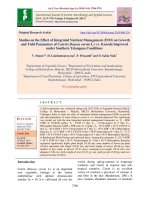

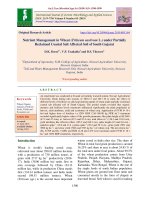

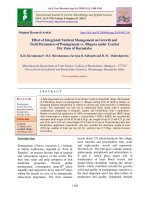
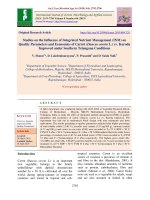

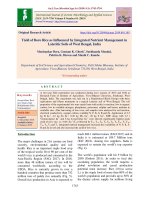

![Generation mean analysis using six parameters genetic model for quantitative traits in cowpea [(Vigna unguiculata (L.) Walp.]](https://media.store123doc.com/images/document/2020_01/14/medium_ccw1578956370.jpg)